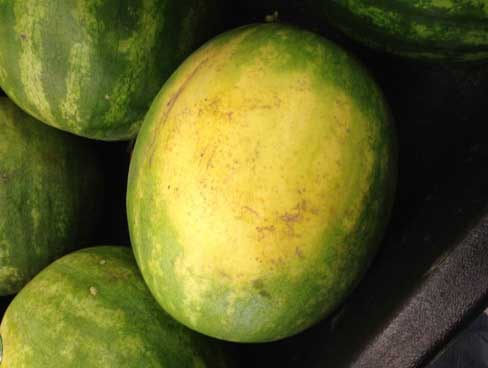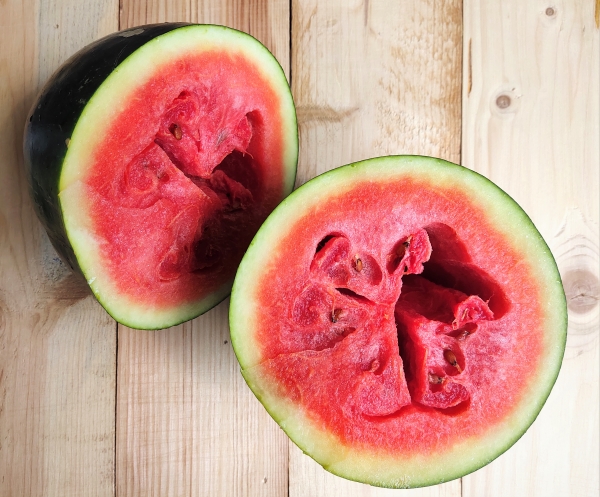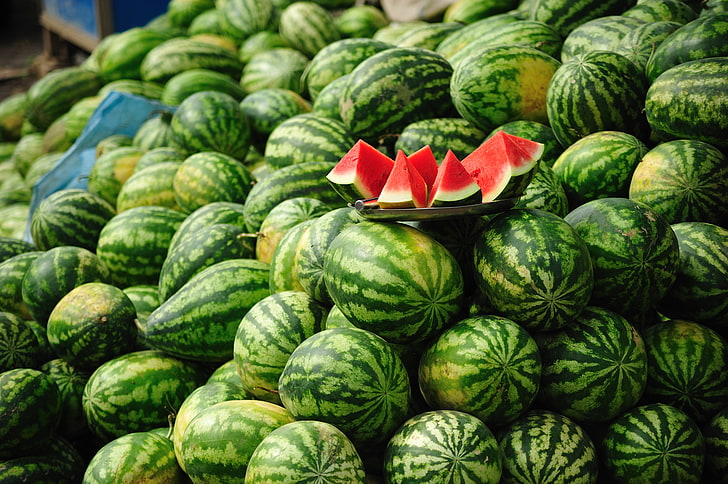Choosing a watermelon is challenging if you do not know what to look for. The big size and thick rind of the fruit make it difficult to know the condition of flesh inside without cutting it. Also, watermelon does not ripe after harvesting so it becomes quite important that how do we pick a watermelon?
So, how to tell if a watermelon is good and ripe?
Look for the Field/Ground Spot
One of the most reliable clues of ripeness is the presence and color of the field spot on watermelon. Field or ground spot on the watermelon is the area that was in contact with the ground throughout its growth.
A watermelon that has a creamy yellow or creamy orange field spot is ripe. If there is no field spot OR it is white-colored OR on the greener side, it is unripe. Avoid them.
If you see stripes running through the field spot in striped watermelon, it is not properly ripe.

Do the Thump Test
Tap on watermelon’s belly with your knuckles. A deep hollow sound like that of knocking on the door hints towards ripeness. Unripe ones will produce a high-pitched sound.
Check if it sounds like you’re knocking on…
- your forehead, it is unripe.
- your chest, it is ripe.
- your belly, it is overripe.
However, the test is subjective and learning differences in sounds is initially a bit difficult, but with practice one can easily do it.
Pay Attention to Size and Weight
Go for medium-sized watermelons rather than extra big or extra small.
Lift the watermelon in hand and go for the one which feels heavier for its size in comparison to others of similar size. Do not take it as the heaviest amongst all else you will mostly end up bringing home the largest watermelon.
Look at the Tail
Watermelon that has a crater (small depression) at the point where it was attached to the vine is a good choice. It indicates that fruit has fallen off the vine on its own after ripening rather than having been plucked.
If watermelon has a tail (a bit of stem), look at its color. A green tail indicates that the watermelon was harvested too early and is not ripe. A dry and brown tail points to ripe watermelon.
Look at the Rind
The rind may be light to dark green, with or without stripes depending on the variety.
Ripe watermelon has a matte or dull-looking rind of a darker shade.
Sometimes rind is covered with a dusty bloom on ripening. It can be easily rubbed off or disappears on handling. So turn around and see if there are any matte patches somewhere if yes, go for it.
A ripe watermelon also feels slightly rough on running your palm on its belly.
Watermelons that have bright and shiny rind are unripe.
Assess the Shape and Firmness
Look for symmetrically shaped watermelons without any dents, bruises or soft spots.
Mature watermelons are normally filled out and blunt on the ends.
Watermelons with pointy ends are still maturing and unripe.
Go for a watermelon that slightly gives way when pressed.
Rock hard ones, as well as those giving too much on pressure are not good choices.
Common Myths Related to Picking a Good Watermelon
Myth #1 Female watermelons (round-shaped) are sweeter than male (oval-shaped) ones.
The truth is that there is nothing like male or female watermelon.
The fact is that watermelon has unisexual flowers means some flowers have the only male reproductive organ (stamen) and some have the only female reproductive organ (pistil). Both male and female flowers grow on the same plant. After pollination the fruit is developed from the ovary. Male flowers do not have ovaries. It means that all watermelons are developed from female flowers. So, neither the plant nor the fruit can be male or female, it is the flowers of watermelon that have sex.
Myth #2. Webbing (brown net-like structure) on the rind indicates sweeter watermelon because bees have touched the flower multiple times resulting in more pollination.
The fact is that if a flower has received a large amount of pollen, the fruit will be big and uniform. Inadequate pollination results in smaller and misshapen fruit.
In watermelon, a condition known as a hollow heart (gaps or cavities in the flesh) may occur due to inadequate pollination.

Second, the flesh of the watermelon we eat develops from the female flower’s ovary and its traits are determined by the parent plant.
How to Buy a Cut Watermelon?
If you are purchasing a cut watermelon, look for bright red flesh with mature dark brown or black seeds.
Avoid melon pieces with:
- white streaks in the flesh
- dry, cracked or grainy flesh
- flesh separating from the seeds
- the visible liquid released from the flesh
As these are signs of old harvest or prolonged storage.
Also, a lot of white seeds in the flesh means a premature harvest, avoid them.
To summarize picking a good watermelon is quite simple; look for the field spot, listen the hollow sound and feel the heaviness. And you are done.


Nice post. I learn something totally new and challenging on websites I stumbleupon everyday. It will always be helpful to read through articles from other writers and practice something from their sites. Anne Sigismund Jaye